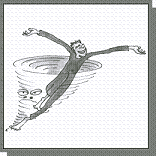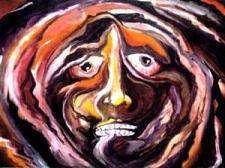 In a previous post, we looked at the vicious cycle of anxiety, in which an anxiety-provoking event triggers an anxiety-related thought, feeling, behaviour or physiological symptom, which generates additional anxious thoughts, feelings, behaviours and physiological symptoms.
In a previous post, we looked at the vicious cycle of anxiety, in which an anxiety-provoking event triggers an anxiety-related thought, feeling, behaviour or physiological symptom, which generates additional anxious thoughts, feelings, behaviours and physiological symptoms. One of the keys to overcoming anxiety is break this cycle before it begins to gain momentum. We often don’t have control of our initial response to an anxiety-provoking situation, but once we become aware that something has triggered an anxiety-related thought, feeling, behaviour or physiological symptom, then we can choose how we react. Mindfulness, and congitive behavioural therapy (CBT) or cognitive therapy, are effective ways to help you stop these cycles before they can build.
Often we respond to our initial anxiety in ways that generate further anxiety-related thoughts, feelings, behaviours or physiological symptoms. This creates a vicious cycle, such as the ones we looked at in an earlier post. However, we can also learn to respond to anxiety is ways that don’t lead to more anxious thoughts, feelings, behaviours or physiological symptoms, preventing the vicious cycle from getting started.
 Often, the first sign of anxiety is physiological. By learning to recognize what your anxiety-related physiological symptoms are, and learning to become aware of them when first start, you can deal with your anxiety before it begins to build. Mindfulness is a great way to learn to become aware of any physiological symptoms you’re experiencing as a result of anxiety.
Often, the first sign of anxiety is physiological. By learning to recognize what your anxiety-related physiological symptoms are, and learning to become aware of them when first start, you can deal with your anxiety before it begins to build. Mindfulness is a great way to learn to become aware of any physiological symptoms you’re experiencing as a result of anxiety.Cognitive therapy, and cognitive behavioural therapy (CBT) are effective tools for helping you to understand how your thoughts and behaviours contribute to your anxiety, and can help you make adjustments in your thinking and behaviours that will allow you to deal with your anxiety, and reduce the amount of anxiety you’ll experience in the future.
Both mindfulness and CBT/cognitive therapy can help you learn to deal with the intense emotions you may experience when you begin to feel anxious, without making these emotions stronger or generating further anxiety.
The earlier in the process you become aware that these vicious cycles of anxiety are starting, the more options you have to deal with them. Once the cycle of anxiety begins to gain momentum, it is more difficult to break.
Mindfulness and cognitive therapy/cognitive-behavioural therapy (CBT) for anxiety can help you recognize the first signs that you’re beginning to feel anxious, and learn how to deal with your anxiety in ways that prevent it from cycling out of control.

I’m a Guelph therapist specializing in helping people overcome anxiety, depression and low self-esteem. For more information about how you can benefit from cognitive therapy/cognitive-behavioural therapy (CBT) for anxiety and mindfulness-based therapy, or to make an appointment for counselling or therapy in Guelph, please call me at 226-500-4086 or email greg@guelphtherapist.ca.





Valuable info. Lucky me I found your site by accident, I bookmarked it.
Really amazing read. Thanks for this information about such an important subject.